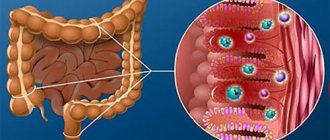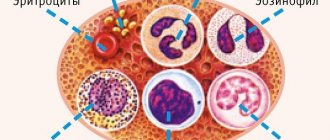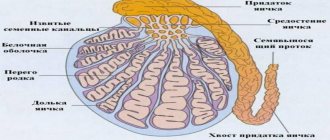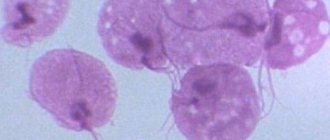According to doctors, the widespread spread of this disease in all countries of the world is associated with a long incubation period, which can be asymptomatic, which is why a person does not see a doctor. The pathological process of chlamydia in men can spread to the prostate gland, spermatic cords, and testicles. If left untreated, this increases the likelihood of developing infertility. Therefore, each of us needs to know more about chlamydia.
- Routes of infection
- Clinical forms of the disease
- Course of the disease
- Complications
- Diagnostics
- Therapy
- Prevention
Chlamydia is a group of infectious diseases that are caused by different types of chlamydia. The urogenital (genitourinary) form of this infection is caused by the gram-negative microorganism Chlamydia trachomatis, which can cause dysfunction of various organs, including the genitourinary. The causative agent of the disease can persist (exist) in the body for decades or even a lifetime, maintaining its pathogenic properties. Pathological bacteria parasitize inside human cells and can remain silent for a long time. But when the immune system is weakened, bacteria immediately begin to actively multiply and, if left untreated, negatively affect the functioning of the entire human body.
Among the entire spectrum of diseases associated with Chlamydia trachomatis, sexually transmitted diseases have acquired particular importance. Most often, they affect people during the period of greatest sexual activity, leading to serious and even irreversible consequences in the form of infertility and neonatal pathologies in the event of a child being born from an infected mother.
Due to the early onset of sexual relations, which is observed in many countries, frequent unprotected sexual intercourse and lack of awareness about the possible consequences of such contacts, there is currently an increase in the incidence of chlamydia not only among adults, but also among adolescents.
Quite often, chlamydial infection is combined with diseases such as trichomoniasis, gonorrhea, syphilis, gardnerellosis, ureaplasmosis, mycoplasmosis and candidiasis. When several infections are combined, the course of the disease worsens, and the patient requires longer treatment.ii Manifestations of the disease can be observed in both women and representatives of the stronger half of humanity. Any suspicious symptoms indicate the need for treatment.
Ways of infection with chlamydia
The causative agent of chlamydial infection is unstable in the external environment and is sensitive to high temperatures. It almost instantly loses its aggressive properties when dried, exposed to chemicals and ultraviolet rays.
Chlamydia infection usually occurs through unprotected sex. Scientists have established contact and vertical mechanisms of transmission of the pathogen. The implementation of the contact mechanism is possible during genital-genital, genital-anal and oral-genital contacts. There is also a household route of transmission of chlamydia in the family through bedding and toiletries, underwear and shared items with an infected person. The vertical mechanism of infection with chlamydia occurs through the placenta and intrapartum, during childbirth.
Today, this disease is epidemiological in nature. This is facilitated by the lack of genetically determined immunity in humans against this infection. The disease suffered in the past does not lead to the creation of stable immunity, which can protect a person from re-infection.iii A urologist treats chlamydia in men.
Frequently asked questions to the doctor
Treatment of chlamydia
Hello, tell me how to cure chlamydia in men?
Many medications are used to treat the disease in men, but primarily antibiotics. Local treatments and injections may be prescribed. Treatment is selected individually for each patient.
Who is doing the treatment?
Which doctor treats chlamydia in men?
Diagnosis of the disease is carried out by specialized specialists. Many patients go to the clinic for help from a urologist. Treatment can be carried out by both a urologist and a venereologist.
Consequences after treatment
Can an inflammatory process develop after treatment has been completed?
After completing therapy, all patients must go to the hospital and undergo follow-up tests. In this way, you can check whether there are still pathogens in the body. If no microorganisms have been identified, you should be examined to identify other sexually transmitted infections that may present with similar symptoms.
Symptoms and development of chlamydia in men
In representatives of the stronger half of humanity, chlamydia is very often subclinical, i.e. occurring in a hidden form. The asymptomatic course of this infection occurs in approximately 46% of men, which often causes difficult diagnosis and treatment. Also, the latent form of the disease increases the risk of complications. After all, even in the absence of any complaints, an infected person is potentially dangerous and can infect their sexual partners.
The early stages of chlamydia are manifested by the development of urethritis, the symptoms of which can gradually increase over several months. At first, the man notices slight discomfort in the urethra and notes the appearance of scanty whitish-transparent discharge. As a rule, at this stage, few people consult a doctor. Then itching and burning appear, which especially bother a man during urination. In this case, discharge from the urethra can become mucopurulent, and swelling and redness are noted around the external opening of the urethra. If you notice similar symptoms, contact a specialist immediately; you need treatment.
In many cases, especially when a man does not suffer from other serious chronic diseases and is not at risk, the symptoms of infection, even without treatment, gradually become less noticeable, and the characteristic discharge appears only in the morning. But this, unfortunately, does not mean that the disease has receded and you can forget about chlamydia and its treatment. The subsidence of symptoms means that the acute phase of chlamydial infection has become chronic, while damage to the urethra and other organs continues. At the same time, as already mentioned, a person can continue to infect everyone with whom he has sexual contact.
Further development of the infection leads to pain of varying intensity in the urethra, scrotum, testicles and lower back. Since chlamydia causes intoxication of the body, body temperature can rise to 37 0C. Urine may change its color and become cloudy, interspersed with threads and substances of pus. In clinical practice, there are also cases when this infection causes bleeding during ejaculation and when visiting the toilet. Sometimes there is also damage to the rectum by chlamydia. In this case, discharge from the anus, itching and pain are possible.
Many patients with chlamydia in the acute phase experience psycho-emotional disorders in the form of sleep disturbances, headaches, irritability and increased weakness. According to one version of psychotherapists, chlamydia is currently considered as one of the etiological agents of chronic fatigue syndrome. This condition also requires treatment.
Prognosis and possible complications
With timely detection and proper treatment, the further prognosis for patients is favorable. In this case, it is possible to avoid complications and completely defeat the infection.
If the disease becomes chronic due to late detection or improper treatment, the patient may develop complications:
- chronic prostatitis;
- orchiepididymitis (inflammation of the tissues of the testicles and their appendages);
- pyelonephritis;
- conjunctivitis;
- chlamydial pharyngitis;
- cystitis;
- infertility.
With complications, the disease is more severe and therapy lasts longer. Moreover, there is a high probability of unsuccessful treatment.
Complications of chlamydia in men
With chlamydial infection, along with urethritis, symptoms of prostatitis, vesiculitis, orchiepididymitis, and funiculitis may be observed. The development of prostatitis begins with the involvement of the prostate gland in the infectious process. The disease manifests itself by such symptoms as unpleasant sensations and discomfort in the lower back, perineum and rectum. The patient is concerned about mucous or watery discharge from the urethra, difficulty urinating and impaired potency.
Infection of the urethra with chlamydia is manifested by severe itching and burning in the urethral area, as well as mucopurulent discharge. There is a frequent painful urge to urinate, which can bother you at any time of the day. Chronicity of the disease can lead to such a serious complication as urethral stricture - a pathological condition that is characterized by narrowing of the urethra and leads to disruption of the normal outflow of urine during urination. With this complication, it becomes impossible to empty the bladder, urinary retention develops, which requires immediate medical attention and further long-term treatment.
Urogenital complications disrupt spermatogenesis and can become the main cause of infertility, which, due to the absence of symptoms, may not be immediately detected.
Etiology of the disease
Chlamydia in men belongs to the group of pathologies of an infectious nature. Their causative agent is Chlamydia trachomatis. Chlamydia, a type of microbe that is close to bacteria and viruses in terms of damaging ability, but has its own morphology, structure and functional characteristics. They are transmitted mainly through unprotected sexual contact with a carrier of chlamydia, regardless of whether it is vaginal, anal or oral.
Less common is chlamydia with a household etiology, transmitted to people who are in close, for example family, contact, through hands or objects contaminated with the pathogen that are touched by everyone: towels, dishes, clothes, bedding.
Symptoms of the disease at its initial stage are imperceptible due to the fact that the microorganism develops only inside epithelial cells. Outside the cell, chlamydia quickly die.
Complications arise when a pathogen from the destroyed cellular tissue of the male genitourinary system penetrates into the intercellular space, blood and bodice and spreads with them to other organs, multiplying exponentially. At the same time, trachomatis actively uses the nutritional and energy capabilities of its owner, reducing its own potential.
Regardless of whether the symptoms of chlamydia are pronounced or not, contact with a carrier of the disease, even during the incubation period, becomes dangerous for his sexual partners. The piquancy of the situation lies in the fact that the suffering party may not know about his illness and infect another simply by accident. There is only one conclusion from here - avoid questionable sexual relationships, especially if they are not protected.
Circumstances favorable to the occurrence of chlamydia in men, in addition to neglect of condoms during sexual intercourse, are:
- Poor nutrition;
- Stressful situations;
- Physical fatigue.
All this reduces immunity and increases the likelihood of developing secondary chlamydial pathologies affecting the respiratory and cardiovascular systems, musculoskeletal system, and visual organs.
But the infection deals the main blow to the genitourinary system, which most often becomes the initial site of penetration and development of the disease. Symptoms of urogenital chlamydia may be similar to the usual manifestations of prostatitis, inflammation of the urethra and bladder.
Diagnosis of chlamydia
Diagnosis and treatment of chlamydia is carried out by urologists. Several different methods are used to detect chlamydia in laboratory practice. One of the most accurate methods is PCR diagnostics (polymerase chain reaction method). With its help, even a minimal amount of a pathogen can be detected in biological material. The accuracy of PCR analysis reaches 95-99%. Completion time: 2–3 days. To conduct this test, a swab is taken from the urethra.iv
To diagnose and draw up a treatment plan for this disease, ELISA (enzyme-linked immunosorbent assay) is also used, with which the presence of antibodies to the pathogen can be detected. With DIF (direct immunofluorescence), microscopy of stained smears is performed. Culture is necessary to determine sensitivity to antibiotics.
In addition to smears from the urethra, urine, blood, seminal fluid and genital secretions are also used as diagnostic material.
Treatment methods for chlamydia in men
Among the main goals of treating this infection are:
- elimination of chlamydia;
- elimination of clinical symptoms of the disease;
- prevention of infection of sexual partners;
- prevention of infection of newborns.
In order for the treatment of the disease to be successful, it is necessary to comprehensively influence the causative agent of the disease. When selecting medications, the doctor must be based on the individual characteristics of the patient, symptoms, stage of the disease and sensitivity of the pathogen to a particular antibiotic. Therapy also takes into account the fact that chlamydia can quickly develop resistance to drug therapy, which requires a prompt response and, if necessary, a change in medications.
To combat chlamydial infection, drugs that belong to three pharmacological groups are most often used: macrolides, tetracyclines and fluoroquinolones. The drug to which the pathogen is most sensitive is selected; its pharmacokinetics should provide a therapeutic concentration in tissues sufficient to suppress the growth of the infectious agent. When drawing up a treatment plan, individual intolerance, age restrictions and concomitant somatic diseases are taken into account. A urologist may recommend antifungal medications, multivitamins, enzymes, bacteriophages, and probiotics - medications that contain strains of beneficial living bacteria necessary for the normal functioning of the entire body. In addition, for effective therapy, physiotherapy may be required - ultrasound therapy, magnetic therapy, iontophoresis and electrophoresis.
During therapy, it is also important to use immunomodulatory agents that will strengthen the immune system and help fight infection. One of these drugs that helps restore the immune system is the drug VIFERON. Thus, in a study conducted by M.A. Gomberg, it is proven that the use of a combination of the drug VIFERON® and a new method of using azithromycin led to the elimination of chlamydia in 96% of patients.v
The drug was developed as a result of fundamental research in the field of immunology, which proved that in the presence of antioxidants (vitamins C, E), the antiviral effect of interferon is enhanced. The drug in the form of suppositories (suppositories) can be used during pregnancy (from the 14th week of gestation), as well as during breastfeeding, for the treatment of newborns, starting from the first days of a child’s life, and the elderly.
The causative agent of chlamydia
Chlamydia trachomatis is a coccus microorganism that affects the genitourinary system. They live and multiply inside the epithelial cells of the urethra using host enzymes. At the same time, chlamydia does not conflict with the human immune system. An inflammatory reaction to this infection, as a rule, does not develop and the disease is asymptomatic. At the end of the parasite's life cycle, numerous elementary bodies are formed that perform the function of spores. They fall out of the destroyed cell, infect surrounding tissues and serve as a source of infection for sexual partners.











